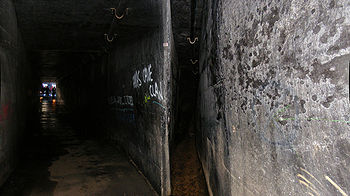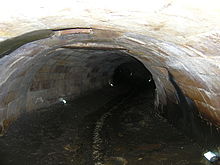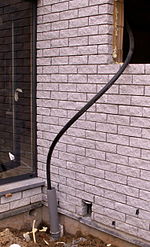- Drainage
-
See also: Storm drain and Stormwater
 Deep inside a Sydney drain in New South Wales
Deep inside a Sydney drain in New South Wales
Drainage is the natural or artificial removal of surface and sub-surface water from an area. Many agricultural soils need drainage to improve production or to manage water supplies.
Contents
History
Early history
The ancient Indus systems of sewerage and drainage that were developed and used in cities throughout the civilization were far more advanced than any found in contemporary urban sites in the Middle East and even more efficient than those in some areas of modern Pakistan and India today. All houses in the major cities of Harappa and Mohenjo-daro had access to water and drainage facilities. Waste water was directed to covered drains, which lined the major streets.[1]
Drainage in the 19th century
 Tank Stream, a historical drain in the City of Sydney
Tank Stream, a historical drain in the City of Sydney
From the 1881 Household Cyclopedia:
This operation is always best performed in spring or summer, when the ground is dry. Main drains ought to be made in every part of the field where a cross-cut or open drain was formerly wanted; they ought to be cut four feet (1.2 m) deep, upon an average. This completely secures them from the possibility of being damaged by the treading of horses or cattle, and being so far below the small drains, clears the water finely out of them. In every situation, pipe-turfs for the main drains, if they can be had, are preferable. If good stiff clay, a single row of pipe-turf; if sandy, a double row. When pipe-turf cannot be got conveniently, a good wedge drain may answer well, when the subsoil is a strong, stiff clay; but if the subsoil be only moderately so, a thorn drain, with couples below, will do still better; and if the subsoil is very sandy, except pipes can be had, it is in vain to attempt under-draining the fiel d by any other method. It may be necessary to mention here that the size of the main drains ought to be regulated according to the length and declivity of the run, and t eihther it can be he quantity of water to be carried off by them. It is always safe, however, to have the main drains large, and plenty of them; for economy here seldom turns out well.
Having finished the main drains, proceed next to make a small drain in every furrow of the field if the ridges formerly have not been less than fifteen feet (4.6 m) wide. But if that should be the case, first level the ridges, and make the drains in the best direction, and at such a distance from each other as may be thought necessary. If the water rises well in the bottom of the drains, they ought to be cut three feet (1 m) deep, and in this ease would dry the field sufficiently well, although they were from twenty-five to thirty feet (8 to 10 m) asunder; but if the water does not draw well to the bottom of the drains, two feet (0.6 m) will be a sufficient deepness for the pipe-drain, and two and a half feet (1 m) for the wedge drain. In no case ought they to be shallower where the field has been previously leveled. In this instance, however, as the surface water is carried off chiefly by the water sinking immediately into the top of the drains, it will be necessary to have the drains much nearer each other—say from fifteen to twenty feet (4.6 to 6 m). If the ridges are more than fifteen feet (4.6 m) wide, however broad and irregular they may be, follow invariably the line of the old furrows, as the best direction for the drains; and, where they are high-gathered ridges, from twenty to twenty-four inches will be a sufficient depth for the pipe-drain, and from twenty-four to thirty inches for the wedge-drain. Particular care should be taken in connecting the small and main drains together, so that the water may have a gentle declivity, with free access into the main drains.
When the drains are finished, the ridges are cleaved down upon the drains by the plough; and where they had been very high formerly, a second clearing may be given; but it is better not to level the ridges too much, for by allowing them to retain a little of their former shape, the ground being lowest immediately where the drains are, the surface water collects upon the top of the drains; and, by shrinking into them, gets freely away. After the field is thus finished, run the new ridges across the small drains, making them about ten feet (3 m) broad, and continue afterwards to plough the field in the same manner as dry land.
It is evident from the above method of draining that the expense will vary very much, according to the quantity of main drains necessary for the field, the distance of the small drains from each other, and the distance the turf is to be carried.
The advantage resulting from under-draining, is very great, for besides a considerable saving annually of water furrowing, cross cutting, etc., the land can often be ploughed and sown to advantage, both in the spring and in the fall of the year, when otherwise it would be found quite impracticable; every species of drilled crops, such as beans, potatoes, turnips, etc., can be cultivated successfully; and every species, both of green and white crops, is less apt to fail in wet and untoward seasons.
Wherever a burst of water appears in any particular spot, the sure and certain way of getting quit of such an evil is to dig hollow drains to such a depth below the surface as is required by the fall or level that can be gained, and by the quantity of water expected to proceed from the burst or spring. Having ascertained the extent of water to be carried off, taken the necessary levels, and cleared a mouth or loading passage for the water, begin the drain at the extremity next to that leader, and go on with the work till the top of the spring is touched, which probably will accomplish the intended object. But if it should not be completely accomplished, run off from the main drain with such a number of branches as may be required to intercept the water, and in this way disappointment will hardly be experienced. Drains, to be substantially useful, should seldom be less than three feet (1 m) in depth, twenty or twenty four inches thereof to be close packed with stones or wood, according to circumstances. The former are the best materials, but in many places are not to be got in sufficient quantities; recourse therefore, must often be made to the latter, though not so effectual or durable.
It is of vast importance to fill up drains as fast as they are dug out; because, if left open for any length of time, the earth is not only apt to fall in but the sides get into a broken, irregular state, which cannot afterwards be completely rectified. A proper covering of straw or sod should be put upon the top of the materials, to keep the surface earth from mixing with them; and where wood is the material used for filling up, a double degree of attention is necessary, otherwise the proposed improvement may be effectually frustrated.
The pit method of draining is a very effectual one, if executed with judgment. When it is sufficiently ascertained where the bed of water is deposited, which can easily be done by boring with an auger, sink a pit into the place of a size which will allow a man freely to work within its bounds. Dig this pit of such a depth as to reach the bed of the water meant to be carried off; and when this depth is attained, which is easily discerned by the rising of the water, fill up the pit with great land-stones and carry off the water by a stout drain to some adjoining ditch or mouth, whence it may proceed to the nearest river.
Current practices
Geotextiles
Modern drainage systems incorporate geotextile filters that retain and prevent fine grains of soil from passing into and clogging the drain. Geotextiles are synthetic textile fabrics specially manufactured for civil and environmental engineering applications. Geotextiles are designed to retain fine soil particles while allowing water to pass through. In a typical drainage system they would be laid along a trench which would then be filled with coarse granular material: gravel, sea shells, stone or rock. The geotextile is then folded over the top of the stone and the trench is then covered by soil. Groundwater seeps through the geotextile and flows within the stone to an outfall. In high groundwater conditions a perforated plastic (PVC or PE) pipe is laid along the base of the drain to increase the volume of water transported in the drain.
Alternatively, prefabricated plastic drainage systems made of HDPE called SmartDitch, often incorporating geotextile, coco fiber or rag filters can be considered. The use of these materials has become increasingly more common due to their ease of use which eliminates the need for transporting and laying stone drainage aggregate which is invariably more expensive than a synthetic drain and concrete liners.
Over the past 30 years geotextile and PVC filters have become the most commonly used soil filter media. They are cheap to produce and easy to lay, with factory controlled properties that ensure long term filtration performance even in fine silty soil conditions.
21st century alternatives
Seattle's Public Utilities created a pilot program called Street Edge Alternatives (SEA Streets) Project. The project focuses on designing a system "to provide drainage that more closely mimics the natural landscape prior to development than traditional piped systems".[2] The streets are characterized by ditches along the side of the roadway, with plantings designed throughout the area. An emphasis on non curbed sidewalks allows water to flow more freely into the areas of permeable surface on the side of the streets. Because of the plantings the run off water from the urban area does not all directly go into the ground but can also be absorbed into the surrounding environment. According to the monitoring by Seattle Public Utilities, they report a 99 percent reduction of storm water leaving the drainage project[2]
Drainage in construction
The civil engineer or site engineer is responsible for drainage in construction projects. They set out from the plans all the roads, street gutters, drainage, culverts and sewers involved in construction operations. During the construction of the work on site he/she will set out all the necessary levels for each of the previously mentioned factors.
Site engineers work alongside architects and construction managers, supervisors, planners, quantity surveyors, the general workforce, as well as subcontractors. Typically, most jurisdictions have some body of drainage law to govern to what degree a landowner can alter the drainage from his parcel.
Green Drain
Enzymatic drain cleaners can be a safer alternative to chemical drain cleaners, and are easier on the environment. They use bacteria or enzymes, which naturally feed on organic waste, such as hair and food waste that often block drains. These tiny organisms, then digest the waste and to recreate beneficial bacteria and enzymes throughout the septic system. In fact, drain cleaners enzyme originally used to clean septic tanks and sewage. Enzymatic drain cleaners are better for the environment because they prevent hazardous chemicals that may leak into soil and water from spreading. [3]
Reasons for artificial drainage
Wetland soils may need drainage to be used for agriculture. In the northern USA and Europe, glaciation created numerous small lakes which gradually filled with humus to make marshes. Some of these were drained using open ditches and trenches to make mucklands, which are primarily used for high value crops such as vegetables.
The largest project of this type in the world has been in process for centuries in the Netherlands. The area between Amsterdam, Haarlem and Leiden was, in prehistoric times swampland and small lakes. Turf cutting (Peat mining), subsidence and shoreline erosion gradually caused the formation of one large lake, the Haarlemmermeer, or lake of Haarlem. The invention of wind powered pumping engines in the 15th century permitted drainage of some of the marginal land, but the final drainage of the lake had to await the design of large, steam powered pumps and agreements between regional authorities. The elimination of the lake occurred between 1849 and 1852, creating thousands of km² of new land.
Coastal plains and river deltas may have seasonally or permanently high water tables and must have drainage[4] improvements if they are to be used for agriculture. An example is the flatwoods citrus-growing region of Florida. After periods of high rainfall, drainage pumps are employed to prevent damage to the citrus groves from overly wet soils. Rice production requires complete control of water, as fields need to be flooded or drained at different stages of the crop cycle. The Netherlands has also led the way in this type of drainage, not only to drain lowland along the shore, but actually pushing back the sea until the original nation has been greatly enlarged.
In moist climates, soils may be adequate for cropping with the exception that they become waterlogged for brief periods each year, from snow melt or from heavy rains. Soils that are predominantly clay will pass water very slowly downward, meanwhile plant roots suffocate because the excessive water around the roots eliminates air movement through the soil.
Other soils may have an impervious layer of mineralized soil, called a hardpan or relatively impervious rock layers may underlie shallow soils. Drainage is especially important in tree fruit production. Soils that are otherwise excellent may be waterlogged for a week of the year, which is sufficient to kill fruit trees and cost the productivity of the land until replacements can be established. In each of these cases appropriate drainage carries off temporary flushes of water to prevent damage to annual or perennial crops.Drier areas are often farmed by irrigation, and one would not consider drainage necessary. However, irrigation water always contains minerals and salts, which can be concentrated to toxic levels by evapotranspiration. Irrigated land may need periodic flushes with excessive irrigation water and drainage to control soil salinity.
 A typical drain in Bankstown, New South Wales.
A typical drain in Bankstown, New South Wales.
See also
- Building construction
- Deep drainage
- Drain (plumbing)
- Drain commissioner
- Drainage basin or watershed
- Drainage by wells
- Drainage divide or watershed
- Drainage equation
- Drainage research
- Drainage systems
- Drainage system (agriculture)
- Geomorphology
- Hydrologic Evaluation of Landfill Performance (HELP)
- Hydrology
- John Johnston, who introduced land drainage to the United States.
- Plumbing
- Potable cold and hot water supply
- Septic systems
- Sewage traps, drains, and vents
- Sewage collection and disposal
- Soil salinity control by subsurface drainage
- Tile drainage
- Trench drain
- Trencher (machine)
- Watertable control
References
- ^ Arthur Coterell (1980). The Encyclopedia of Ancient Civilisations. Rainbird Publishers. pp. 176–178. ISBN 0-7112-0036-X.
- ^ a b Seattle: Natural Drainage Systems
- ^ Go Green
- ^ Drain Tiles
External links
- American Wick Drain- Manufacturer of prefabricated sheet drain
- International Geosynthetics Society, information on geotextiles and geosynthetics in general.
- WebCom Systems, software created for designing soakaways and filter trenches.
- DRAINMOD, software created for modeling agricultural tile and ditch drainage.
- Drainage Systems, drainage systems revealed, drainage tips and guide, plans and photos.
- River water higher than land
- NDS, drainage calculator.
- Ancient drains, a series of images of the earliest drainage systems in the ancient Indus city of Mohenjo daro
- Draining for Profit, and Draining for Health by George E. Waring, 1867, from Project Gutenberg
- Drainage Channel, Information on drainage systems for commercial use
- Drainage Resources, Systems and Technology, Specification Drainage Resources
- Drainage photos
- Stormwater Drainage Design information on stormwater design, drainage and on-site detention
- Waterlogging, free downloads of articles and software on agricultural land drainage.
- ADS-Pipe Drainage Calculators, web based and MS Excel drain calculators.
- Principles of Exterior Drainage, installation guide.
- SmartDitch, Drainage Control System
- Sustainable Residential Design: Improving Water Efficiency Resource Guide
Infrastructure Bridge · Canal · Dam · Drainage · Footbridge · Interchange · Levee · Overpass · Road · Skyway · Storm drain · Tunnel
See also: Architecture · Amphitheatre · Civil engineering · Construction · Playground · Urban park
Agricultural water management Irrigation Surface irrigation · Tidal irrigation · Irrigation of alluvial fans · Irrigation statistics · Irrigation management · Irrigation environmental impactsSubsurface drainage Surface water/runoff Groundwater Groundwater flow · Groundwater energy balance · Groundwater model · Hydraulic conductivity · WatertableProblem soils Agro-hydro-salinity group Hydrology (agriculture) · Soil salinity control · Leaching model (soil) · SaltMod integrated model · SahysMod polygonal model: Saltmod coupled to a groundwater modelRelated topics Sand dam ·Categories:
Wikimedia Foundation. 2010.



